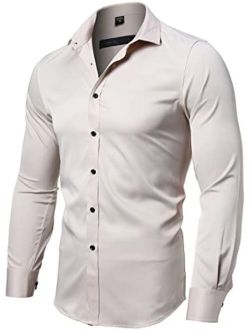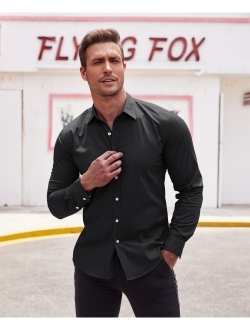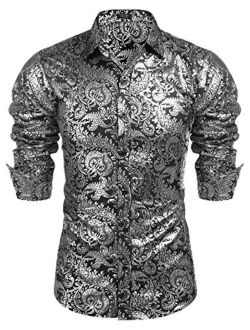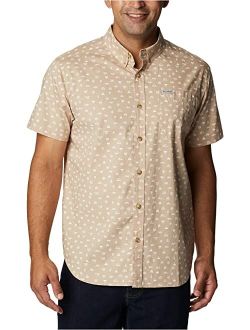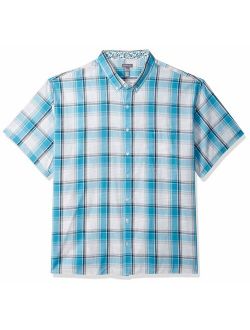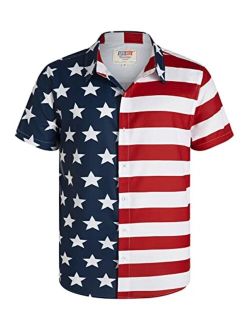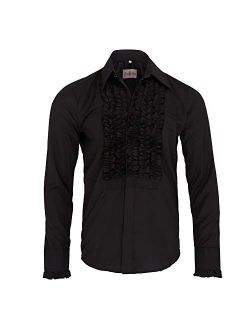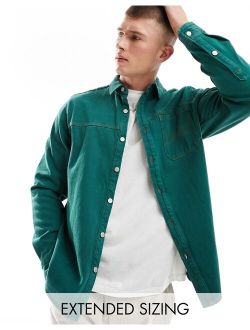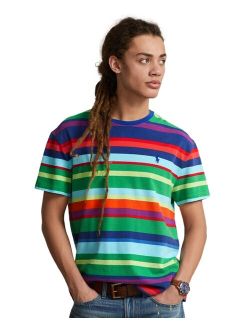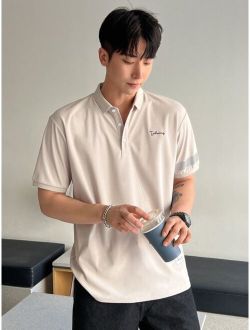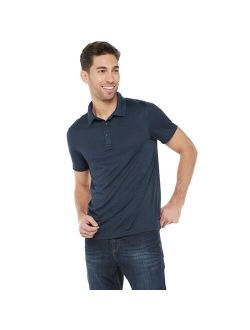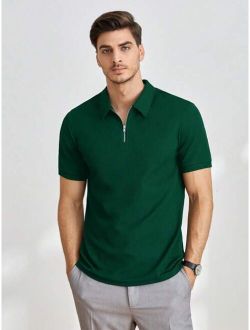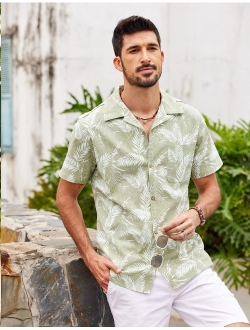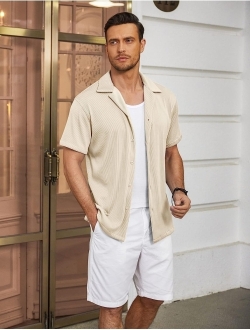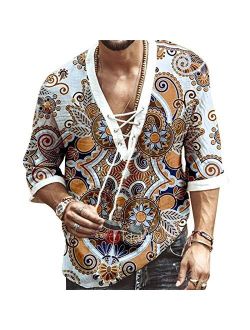A to Z Shirts Guide for Men: Types, Patterns & Tips

Shirts are a quintessential part of a man’s wardrobe. With the right shirt, you can define your look and leave everyone impressed. Hence, it is paramount to understand the different types of shirts that are available, and the right way to wear them.
15 Types of Shirts Designs for Men
- Button-up Shirt
- Oxford Shirt
- Dress Shirt
- Classic Short Sleeve Shirt
- Tuxedo Shirt
- Cuban Collar Shirt
- Flannel Shirt
- Denim Shirt
- Polo Shirt
- Shacket/Overshirt
- Chambray
- Linen Shirt
- Aloha/Hawaiian Shirt
- Camp shirt/Cabin/Cabana/Lounge Shirt
- Bowling shirt
1. Button-up Shirt

That’s the name for your basic long-sleeved or half-sleeved shirt that has buttons all the way up. Your office wear shirts are button-up shirts, though they are available in casual wear too.
Best Pair of Pant: Dress Pant, Jeans, Wool Trouser, Moleskin Trouser, Corduroy Trousers, Chinos, Cargo, Cropped Trouser.
Worst to Put On: Jogger, Track Pant.
Occasion: Formal, Semi-Formal, Casual
Recommended Button-up Shirts For You
2. Oxford Shirt
 Similar to a button-up shirt, the oxford shirt has an additional button on the collar and usually comes in a thick fabric. This very traditional shirt is ideal for wearing to your office or a wedding.
Similar to a button-up shirt, the oxford shirt has an additional button on the collar and usually comes in a thick fabric. This very traditional shirt is ideal for wearing to your office or a wedding.
Best Pair of Pant: Dress pant, Jeans, Wool Trouser, Moleskin Trouser, Corduroy Trousers, Chinos, Cropped Trouser
Worst to Put On: Jogger, Track Pant, Cargo
Occasion: Formal, Semi-Formal, Casual
3. Dress Shirt
 A dress shirt is an essential choice for an office capsule wardrobe. They come in an assortment of prints, patterns, and colors like blue, beige, grey, etc. Opt for a two-ply, herringbone, or oxford weave for a dapper look.
A dress shirt is an essential choice for an office capsule wardrobe. They come in an assortment of prints, patterns, and colors like blue, beige, grey, etc. Opt for a two-ply, herringbone, or oxford weave for a dapper look.
Best Pair of Pant: Dress Pant, Moleskin Trouser, Wool Trouser, Chinos, Corduroy Trousers
Worst to Put On: Jeans, Cargo, Cropped Trouser, Corduroy Trousers, Jogger, Track Pant
Occasion: Formal, Semi-Formal
Recommended Dress Shirts For You
4. Classic Short Sleeve Shirt
 Suitable for casual settings, this shirt has an open, pointed collar and it comes in a wide range of patterns and prints. It makes for a perfect combination of jeans, chinos, and shorts.
Suitable for casual settings, this shirt has an open, pointed collar and it comes in a wide range of patterns and prints. It makes for a perfect combination of jeans, chinos, and shorts.
Best Pair of Pant: Dress pant, Chinos, Jeans, Moleskin Trouser, Corduroy Trousers, Cargo, Cropped Trouser, Jogger
Worst to Put On: Cropped Trouser, Wool Trouser, Track Pant
Occasion: Semi-Formal, Casual
Recommended Short Sleeve Shirts For You
5. Tuxedo Shirt
 It is a full-length shirt suited for formal events where you can wear it with a tuxedo or a jacket. It has buttons or prominent shirt studs for fastening, a cutaway or wing collar, and double cuffs.
It is a full-length shirt suited for formal events where you can wear it with a tuxedo or a jacket. It has buttons or prominent shirt studs for fastening, a cutaway or wing collar, and double cuffs.
Best Pair of Pant: Dress Pant, Wool Pant
Worst to Put On: Corduroy Trousers, Jogger, Chinos, Jeans, Moleskin, Cargo, Track Pant, Cropped Trouser
Occasion: Formal
Recommended Tuxedo Shirts For You
6. Cuban Collar Shirt
 It has short sleeves and an open collar, which makes it an ideal summer outfit. It comes in vivid hues and designs, making it suitable for casual events and festive occasions.
It has short sleeves and an open collar, which makes it an ideal summer outfit. It comes in vivid hues and designs, making it suitable for casual events and festive occasions.
Best Pair of Pant: Pleated/Non-Pleated Dress Pant, Moleskin Trouser, Chinos, Cargo, Jeans, Cropped Trouser
Worst to Put On: Corduroy Trousers, Wool Trouser, Track Pant, Jogger
Occasion: Cool Casual
7. Flannel Shirt
 If the frosty weather is giving you chills, wear a Flannel shirt whose thick fabric will keep you warm. It comes in a checkered pattern and can be worn with jeans or layered over a T-shirt
If the frosty weather is giving you chills, wear a Flannel shirt whose thick fabric will keep you warm. It comes in a checkered pattern and can be worn with jeans or layered over a T-shirt
Best Pair of Pant: Jeans, Cargo Trouser, Chinos, Jogger
Worst to Put On: Cropped Trouser, Corduroy Trousers, Dress Pant, Track Pant, Wool Trouser
Occasion: Casual
Recommended Flannel Shirts For You
8. Denim Shirt
 Denim is a fashion mainstay, and a denim shirt can give you an uber-cool look. When opting for a denim shirt, go for a relaxed fit and team it with dark-colored jeans. You can also wear it over a light-colored T-shirt.
Denim is a fashion mainstay, and a denim shirt can give you an uber-cool look. When opting for a denim shirt, go for a relaxed fit and team it with dark-colored jeans. You can also wear it over a light-colored T-shirt.
Best Pair of Pant: Jeans, Chinos, Cargo, Corduroy Trousers, Jogger, Relax fit Dress Pant, Cropped Trouser
Worst to Put On: Track Pant, Wool Trouser, Moleskin Trouser, Dress Pant
Occasion: Casual, Semi-Formal
Recommended Denim Shirts For You
9. Polo Shirt
 A polo shirt is a cotton T-shirt with a collar and a few buttons on the neck. If you want to wear a T-shirt to a party or a casual event, pick up a Polo T-shirt for the occasion.
A polo shirt is a cotton T-shirt with a collar and a few buttons on the neck. If you want to wear a T-shirt to a party or a casual event, pick up a Polo T-shirt for the occasion.
Best Pair of Pant: Relaxed fit Dress Pant, Jeans, Cropped Trouser, Chinos, Moleskin Trouser, Cargo, Jogger, Track Pant, Corduroy Trousers
Worst to Put On: Wool Trouser
Occasion: Casual
Recommended Polo Shirts For You
10. Shacket/Overshirt
 This shirt is worn like a jacket, hence it earned the sobriquet ‘shacket’. Wear a shacket in a neutral shade with a solid colored T-shirt for a day out.
This shirt is worn like a jacket, hence it earned the sobriquet ‘shacket’. Wear a shacket in a neutral shade with a solid colored T-shirt for a day out.
Best Pair of Pant: Relaxed fit Dress Pant, Jeans, Cropped Trouser, Chinos, Moleskin Trouser, Cargo, Jogger, Track Pant, Corduroy Trousers, Wool Trouser
Worst to Put On: None
Occasion: Casual
Recommended Overshirts For You
11. Chambray
 A light-weight shirt that resembles a denim shirt, this is a comfortable yet stylish choice of a casual shirt that can be worn with chinos or jeans.
A light-weight shirt that resembles a denim shirt, this is a comfortable yet stylish choice of a casual shirt that can be worn with chinos or jeans.
Best Pair of Pant: Chinos, Jeans, Relax fit Dress Pant, Corduroy Trousers, Cargo, Cropped Trouser
Worst to Put On: Track Pant, Wool Trouser, Cargo, Jogger, Moleskin Trouser
Occasion: Casual, Semi-Formal
12. Linen Shirt
 If you need a shirt that gives you respite from the scorching sun, linen shirts come to your rescue. They are breathable and soft, and one can also pair them with jeans and chinos as well as blazer or jacket, depending on whether the occasion is casual or formal.
If you need a shirt that gives you respite from the scorching sun, linen shirts come to your rescue. They are breathable and soft, and one can also pair them with jeans and chinos as well as blazer or jacket, depending on whether the occasion is casual or formal.
Best Pair of Pant: Chinos, Jeans, Dress Pant, Cropped Trouser
Worst to Put On: Corduroy Trousers, Wool Trouser, Jogger, Track Pant, Moleskin Trouser
Occasion: Semi-Formal, Casual
Recommended Linen Shirts For You
13. Aloha/Hawaiian Shirt
 It is a brightly printed buttoned shirt from Hawaii, and it comes in short sleeves with a collar. It is perfect for a day out by the sea.
It is a brightly printed buttoned shirt from Hawaii, and it comes in short sleeves with a collar. It is perfect for a day out by the sea.
Best Pair of Pant: Pleated/Non-Pleated Dress Pant, Moleskin Trouser, Chinos, Cargo, Jeans, Cropped Trouser
Worst to Put On: Corduroy Trousers, Wool Trouser, Track Pant, Jogger
Occasion: Casual, Semi-Formal
Recommended Hawaiian Shirts For You
14. Camp shirt/ Cabin/ Cabana/ Lounge Shirt
 If you want a shirt that you can put on and unwind, go for a lounge shirt. It is a loose, button-up shirt that comes in straight cut and with short sleeves, and it usually comes in plain colors.
If you want a shirt that you can put on and unwind, go for a lounge shirt. It is a loose, button-up shirt that comes in straight cut and with short sleeves, and it usually comes in plain colors.
Best Pair of Pant: Casual Pants, Moleskin Trouser, Chinos, Jeans, Corduroy Trousers, Wool Trouser, Track pant, Cropped Pant, Shorts
Worst to Put On: Joggers, Harem Pant, Breeches
Occasion: Casual
15. Bowling shirt
 Bowling shirt is a stylish spin on the camp shirt, with variations in fabric, colors, and designs. It usually has a pocket, monogram, or some kind of initials on the left chest.
Bowling shirt is a stylish spin on the camp shirt, with variations in fabric, colors, and designs. It usually has a pocket, monogram, or some kind of initials on the left chest.
Best Pair of Pant: Casual Pants, Moleskin Trouser, Chinos, Jeans, Corduroy Trousers, Wool Trouser, Track pant, Cropped Pant, Work Pant, Shorts
Worst to Put On: Joggers, Harem Pant, Breeches
Occasion: Casual, Formal
11 Types of Patterns for Shirt Fabric
- Plain/ Solid
- Checks
- Graph Check/ Box Check
- Windowpane
- Tattersall
- Gingham / Vichy
- Shepherd’s check
- Gun Club Check
- Plaid
- Tartan
- Madras Checks
- Glen plaid/Prince of Wales Checks
- Buffalo Checks
The world of shirts is very vast, there are not just assortments in styles and cuts, but there are also a plethora of surface patterns- and each pattern has a distinct look. Let us learn a bit about them.
1. Plain/ Solid

A solid or a plain shirt comes in a single, uniform color- with no prints or patterns. Light-colored solid shirts make you look broader, and are suitable for formal settings, whereas darker ones have a slimming effect and they are great for casual events.
2. Checks

A checked shirt has crossed lines of two alternating colors that make symmetrical squares all over the shirt.
3. Graph Check/ Box Check

A box check shirt has lines in one color that make equally-sized grids on the shirt, where the grids can be small to a three-quarter inch in width. Smaller grids are suitable for formal wear while bigger grids give the shirt a casual appearance.
4. Windowpane

It is also called a double-lined pattern. It consists of rectangular checks that resemble a windowpane, hence the name.
5. Tattersall

It is just like the graph check pattern, however, Tattersall has lines in two complimentary colors.
6. Gingham / Vichy

This pattern consists of thick lines of one color, crisscrossing each other at equal distance, against a contrasting background color.
7. Shepherd’s check

It is similar to the gingham pattern but what makes the shepherd’s check different from it is the visible diagonal twill leave pattern.
8. Gun Club Check

An American Gun Club incorporated this pattern in its uniform, hence the name. The checks were made of evenly thick lines in four different colors- black, rust, gold, and green. It also has a visible diagonal twill pattern, and now gun club checks in two colors have become common as well.
9. Plaid

Uneven checks in a criss-cross pattern by intersecting lines of varying thickness in one, two, or three colors.
10. Tartan

It forms with lines of different widths in three or more colors in addition to base colors.
11. Madras Checks

This pattern has uneven checks that consist of multiple bright colors. This pattern is mostly found in summer clothing.
12. Glen plaid/Prince of Wales Checks

A glen check has woven twill designs with small and large checks. It usually comes in muted colors, with two dark and two light stripes alternating with four dark & four light stripes to form irregular checks.
13. Buffalo Checks

Buffalo check is large blocks formed by the intersection of red and black colors.
Shirt Anatomy
Since shirts make up an indispensable part of men’s wear, one must also know the different parts of a shirt.

Collar: The neck part of the shirt, when concealed with a band is called a collar. This band can be rolled or folded over. Men’s shirt has a wide range of collar styles, you should select the one that suits your face-cut.
Pockets: A single pocket on the chest may be present on casual shirts. Formal shirts don’t have pockets.
Yoke– It is the double-layered piece sewn below the neck and shoulders. It can be split into two pieces, and each piece is called a split yoke.
Placket front– The fabric strip is sewn on top of the front shirt body, on which buttonholes are placed. There are 3 types of Placket front as described below.
American placket: It’s also called the traditional placket, this style has a separate piece of fabric attached folding or stitching to the shirt front.
French placket: Also called plain placket, this style has the shirt material folded underside. The stitches are present in the underside but not visible as a top seam.
Hidden/Fly front placket: As the name suggests, a nicely folded and stitched flap conceals the front button of the shirt in the Fly Front Pocket style.
Armhole– The opening of the shirt where the arm goes. It is the circumference of shoulder to the underarm area, to which the sleeves are attached.
Sleeve– The fabric that covers the arms, from upper arm to wrist. The cuffs are placed where the sleeves end.
Sleeve placket– A slit at the end of the sleeve that allows your hand to go comfortably through the sleeve. A narrow cloth strip is sewn on the cuff that you can button-up to the sleeve and hide the slit.
Cuff– It is a rounded or squared band that forms the bottom part of a sleeve. There are 3 types of cuff in men’s shirts.
- Straight Cuff/Square Cuff- The standard dress cuff with one button barrel, it is suitable for all occasions.
- French Cuff– This square-shaped cuff is worn with cuff-links and it is the cuff that you should wear with a tuxedo.
- Curved Cuff- Similar to the straight cuff, it is ideal for men with longer arms as it gives them a balanced look.
Hang loop- A small strip of cloth sewn on the underside of the yolk, which can be used to hang a shirt.
Shirt Back Designs
Pleats or back darts can help define the back of the shirt. Pleats also make a wide range of movement of the arms possible. Darts are two seams sewn into the back of the shirt for contouring the garment. They help achieve a pronounced cinched effect on the waist. Let us have a look at the variations achieved using pleats and darts on a shirt back.
Plain back shirt– With no pleats or darts, this shirt is ideal for skinny or athletic men.
Two pleats on the back– Two half-inches pleats made just below the yoke near the shoulder blades, to make the shirt align better with the back. Good for athletic or broad-shouldered men as it facilitates movement.
Box pleated shirt– A 1.5 to 2 inches wide double folded pleat, made just below the yoke at the of the back. This pleat assures more movement to the wearer, making it ideal for masculine men.
Darts
Two darts in the back– This contours the extra fabric in the shirt, and it is suitable for a skinny or athletic body.
3 Types of Hemline for Shirt
The tail is the part of a shirt that extends below the waistline. The finished bottom edge of the shirt is called the hem. Let’s have a look at the types of hemlines.
- U Hem- U shaped hems can be tucked in or left tucked out, hence suitable for formal as well as casual occasions.
- Straight cut hem– It is less versatile and suited for casual wear
- Hem Gazette– A style element for shirts rather than a reflection of its suitability for casual or formal occasions.
4 Types of Fitting for Shirt
Buying a shirt with the right fit is an absolute must. That’s because the fit has a crucial role in defining your look, and alterations are expensive if you buy a shirt with a wrong fit. Before you head out to make a purchase, learn about the different fits that men’s shirts come in-
1. Classic / Relaxed Fit
The shirt has 3 to 4 inches of fabric allowance around the actual chest, leaving more space for air. It has a traditional tailoring silhouette, which gives a boxier shape. It is ideal for those weight extra flab, or who regularly wear a jacket over their shirts.
2. Modern Fit / Regular Fit
It has a 1.5 to 2 inches allowance at the chest, with high-cut armhole. It lies somewhere in between the relaxed fit and the regular fit. It will create a tapered silhouette without sacrificing your comfort.
3. Slim Fit
It has a 1 to 1.5 inches ease at the chest with a higher armhole and tapering sleeves. It is a well-fitted shirt that accentuates your shape and restricts body movement. Wear it only if you have the physique to justify it.
4. Super Slim/ Skinny Fit
This fit is popular among young men who prefer really tight outfits. Stay away from it unless you are very skinny, as this fit is neither flattering nor comfortable.
5 Types of Roll Sleeve Methods for Shirt

When you are not wearing a suit jacket for an important meeting, you can keep your sleeves rolled up in your workplace. However, you must learn to roll them with a finesse for a crisp and polished look. Here are a few ways to roll up your sleeves.
1. Aifa Roll/ Forearm Roll
The unbuttoned cuff is flipped back and inside out once and then the button is fastened. The rolled cuff will sit on your forearm.
2. Basic Roll
It is similar to the Aifa roll, however, the cuff is folded over two times. The rolled cuff will sit just below your elbow.
3. High Roller
It is similar to the two rolls mentioned above, but here the cuff is folded over three times. The rolled cuff will sit on your bicep.
4 Master Roll
In this roll, you flip the cuff and bring it just below the elbow without folding, then folder and roll over the excess fabric so that it locks the cuff bottom.
5. Garter Roll
An elastic garter is used to pull the sleeves upwards, and the garter is then hidden with the excess fabric.
Basic Rules for Shirt Tuck-in

Align the placket straight across all the way, lining up buckle and zipper to get the right tucking.

Tucked-in shirt: Shirt length in between mid-crotch to a zipper or longer.
Untucked Shirt: Shirt length should end up in the mid-crotch area.
The front of a shirt should end in between the mid-fly and the end of the zipper. The back hem should end between the mid-back pocket and the bottom of the back pocket.
Excessive Fabric while tuck-in? Try Military Tuck

Take a pinch of extra fabric from each side seam between your thumb and forefinger, and fold back quickly inside the trouser.
Basic Shirt Fitting Rules Every Man Should Know
Invest in Shirt Stay to keep shirt tucked

Shirt garters pairs have clips attached to both ends of an elastic strip, put on clip on your shirttail and another on your socks, and then put on your trousers for a perfect tuck. Use garters on the left and right side of both front and back hem.
Shirt Fitting Rule to Check Before Buying

You should be able to slip two fingers easily between your collar and neck at any point.
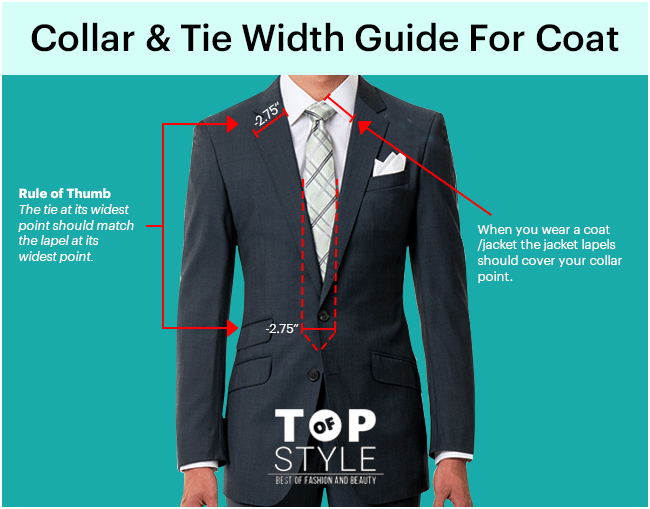
When you wear a jacket the jacket lapels should cover your collar point.

Check if you can slide two fingers beneath the cuff, there should be space for a watch between the fabric and your wrist.

If you are selecting a Short Sleeve Shirt, ensure that the sleeves of shirt end between the midriff and 3/4th of a bicep.
The sleeves should not be too tight, it should be a bit lose at the bicep so that you can freely move your arms.
Your armholes should fit you well, otherwise moving your hands will be either uncomfortable or it will untuck your shirt. If you lift your arms at 45 degrees and your shirt hem comes out of your trousers by more than an inch, then the armholes are too low cut for your body.

Shirt sleeve cuff should end 1 inch beyond the hinge of the wrist bone or where the palm meets the wrist.
A well-fitted shirt not just highlights your contour for a crisp look, it also gives you comfort and freedom of movement. So it is highly useful to know how to measure a shirt before you buy one.
Ultimate Shirts and Neckties Matching Guide

You can look crisp and chic by incorporating neckties in your attire. Neckties are grouped into two categories.
A well-dressed man exudes confidence and power. So keep these points in mind when you are out shopping, as looking suave is simple if you know how to select the right shirt for you.







